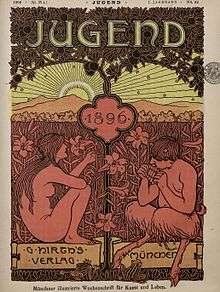Jugend (magazine)

Jugend ("Youth" in German) was a German art magazine that was created in the late 19th century. The magazine was based in Munich.[1] It featured many famous Art Nouveau artists and is the source of the term "Jugendstil" ("Jugend-style"), the German version of Art Nouveau. The magazine was founded by writer Georg Hirth. It was published from 1896 to 1940. After the death of Hirth in 1916, Franz Schoenberner became the publisher. Editors who worked on Jugend include Hans E. Hirsch, Theodore Riegler and Wolfgang Petzet. There were also the text editors, such as Fritz von Ostini and Albert Matthew, and the photo editor Heinrich Franz Lang.
Jugend became the namesake of the art direction of German Art Nouveau. In addition to modern illustrations and ornamentation of art nouveau, other styles played a role, especially Impressionism. The journal also covered satirical and critical topics in culture, such as the increasing influence of the churches, (especially Catholicism) and the political right in the Centre Party. The contribution of Jugend to the literature of the early modern period, however, remained modest – in contrast to the competing journal Simplicissimus (also founded in 1896 by the publisher Albert Langen).
From the First World War, Jugend was becoming a national German and Bavarian magazine. That changed until the mid-1920s, when the issues began catering to the artists of the younger generation. After 1933, the magazine changed to fit in with the trend of National Socialism; nevertheless, it lasted until 1940.
References
- ↑ The Weimar Etudes. Columbia University Press. 13 August 2013. p. 93. ISBN 978-0-231-53136-8. Retrieved 23 February 2016.
External links
| Wikimedia Commons has media related to Die Jugend. |
- Jugend – Münchner illustrierte Wochenschrift für Kunst und Leben – digital version at University Library Heidelberg